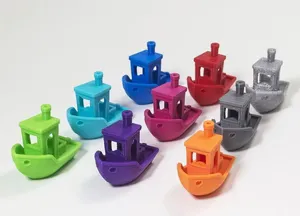Blog

3D Printing for Beginners by ChatGPT App.
“3D Printing for Beginners by ChatGPT App.” - by David Mor December 16, 2022
Introduction:
For this article I decided to consult with the new ChatGPT app that everyone has been talking about lately. ChatGPT (Generative Pre-training Transformer), which is a machine learning model developed by OpenAI that is designed to generate human-like text. It is often used for tasks such as language translation, question answering, and text generation.
I think ChatGPT did a briliant job with this article and I recommend the 5 min read. Enjoy and let me know in the comments below your opinion on this awesome article by an AI machine...
"3D printing, also known as additive manufacturing, is a process of creating three-dimensional objects by building them layer by layer using a variety of materials, including plastics, metals, and ceramics. It has revolutionized the way we manufacture products, allowing for greater design flexibility, faster production times, and reduced costs.
For beginners, 3D printing can seem like a daunting and complex technology. However, with the right tools and knowledge, it is a relatively straightforward process that can open up a world of possibilities. In this article, we will provide an overview of 3D printing for beginners, covering the basics of how it works, the different types of 3D printers available, and some practical tips for getting started.

How Does 3D Printing Work? 👊
At its most basic, 3D printing involves using a digital file, known as a 3D model, as a blueprint for creating an object. The 3D model is sliced into thin layers, which are then printed one at a time, building up the object layer by layer.
There are several different technologies used in 3D printing, including fused deposition modeling (FDM), selective laser sintering (SLS), and stereo lithography (SLA). Each of these technologies works slightly differently, but the basic principle is the same: a 3D printer deposits material in a specific pattern to create the desired object.
TYPES OF 3D PRINTERS
There are many different types of 3D printers available on the market, ranging from low-cost hobbyist machines to professional-grade industrial printers. Some of the most common types of 3D printers include:
Fused deposition modeling (FDM) printers: These are the most common type of 3D printer, and they work by melting and extruding a plastic filament through a heated nozzle to create the object. FDM printers are relatively inexpensive and are suitable for a wide range of applications, including prototyping, engineering, and education.
Selective laser sintering (SLS) printers: These printers use a high-powered laser to fuse together small particles of plastic, metal, or ceramic to create the object. SLS printers are more expensive than FDM printers and are typically used in industrial settings for producing high-quality, functional parts.
Stereo lithography (SLA) printers: These printers use a laser to cure a liquid resin into a solid object. SLA printers produce highly detailed and accurate prints, but they are generally more expensive than FDM and SLS printers
GETTING STARTED WITH 3D PRINTING
If you're new to 3D printing, there are a few steps you can follow to get started:
Choose a 3D printer: Decide on the type of 3D printer that best fits your needs and budget. Consider factors such as the size and precision of the objects you want to print, the materials you want to use, and the level of complexity you are comfortable with.
Acquire a 3D model: You can create your own 3D models using computer-aided design (CAD) software or download pre-made models from online libraries such as Thingiverse or MyMiniFactory.
Prepare the 3D model for printing: Most 3D printers require the model to be "sliced" into thin layers, which can be done using slicing software such as Cura or Slic3r. The slicing software will also allow you to adjust settings such as infill, layer height, and support material.
Print the object: Follow the instructions provided by your 3D printer to load the material and start the printing process. Be sure to monitor the progress of the
TIPS FOR SUCCESSFUL 3D PRINTING
Once you have a 3D printer and a model ready to go, there are a few things you can do to increase your chances of success and produce high-quality prints. Here are some tips to keep in mind:
Calibrate your printer: Proper calibration is crucial for achieving accurate and reliable prints. Make sure your printer is level, and follow the manufacturer's instructions for calibrating the bed and nozzle height.
Use the right material: Different materials have different properties, and some are better suited for certain applications than others. For example, PLA (polylactic acid) is a popular choice for beginners because it is easy to print with and has good stability, but it may not be suitable for high-temperature or high-stress applications.
Pay attention to the print bed: The print bed is where the object is built, and it is important to make sure it is clean, level, and properly heated. Depending on the material you are using, you may need to apply a layer of adhesive or use a special bed surface to improve adhesion.
Experiment with settings: Every printer is different, and the ideal settings will depend on your specific machine and the material you are using. Don't be afraid to try different combinations of infill, layer height, and other settings to see what works best for you.
Use supports: Some 3D models have overhanging or angled features that may require the use of support structures to maintain their shape while printing. These structures can be easily removed once the print is finished, and they can help to improve the overall quality of the print.
APPLICATIONS OF 3D PRINTING
3D printing has a wide range of applications and is being used in many different industries. Some of the most common uses of 3D printing include:
Prototyping: 3D printing allows designers and engineers to quickly and cheaply create prototypes of their products, allowing for faster iteration and testing.
Customization: 3D printing allows for the production of highly customized products, from custom-fit prosthetics to personalized jewelry.
Manufacturing: Many companies are using 3D printing to produce small batches of custom or specialized parts, reducing the need for large-scale production and storage.
Education: 3D printing is being used in schools and universities to teach students about design, engineering, and manufacturing concepts.
Medicine: 3D printing is being used to create custom prosthetics, implants, and other medical devices, as well as to produce personalized medicine such as 3D-printed pills.
FUTURE OF 3D PRINTING
3D printing technology is constantly evolving, and there are many exciting developments on the horizon. Some of the areas where 3D printing is likely to have a major impact in the future include:
Space exploration: 3D printing could be used to produce parts and tools on demand for use in space missions, reducing the need for large amounts of supplies to be carried on spacecraft.
Construction: 3D printing could potentially be used to build entire structures, from houses to bridges, using a variety of materials such as concrete and metals.
Food production: 3D printing could be used to create custom-made meals, using a variety of plant-based and alternative protein sources.
Bioprinting: Scientists are working on using 3D printing to create living tissue and organs, which could potentially revolutionize the field of medicine and help to address the shortage of donor organs.
3D PRINTING LIFE HACKS
As with any technology, there are always ways to make 3D printing more efficient and effective. Here are a few life hacks that can help you get the most out of your 3D printer:
Use a enclosure: If you are using a filament-based printer, an enclosure can help to maintain a consistent temperature and reduce the risk of warping. You can build your own enclosure using materials such as cardboard or acrylic, or you can purchase a pre-made enclosure.
Print multiple objects at once: If you have a large build plate, you can print multiple objects at once to save time and material. Just be sure to leave enough space between the objects to allow for proper cooling and support.
Use a raft: If you are having trouble with bed adhesion, you can use a raft to help hold the object in place while printing. A raft is a layer of plastic that is printed beneath the object and can be easily removed once the print is finished.
Use a filament drying system: If you are using a filament-based printer, moisture in the filament can cause problems such as clogging and poor bed adhesion. A filament drying system can help to remove excess moisture and improve the overall quality of your prints.
Use a spool holder: If you are using a spool of filament, a spool holder can help to keep the filament from tangling and ensure that it feeds smoothly into the printer.
Use a filament cleaner: If you are using a flexible filament, it can sometimes pick up small bits of debris or dust that can cause problems in the printer. A filament cleaner is a simple device that can help to remove these contaminants and improve the overall quality of your prints.
CONCLUSION
3D printing is a powerful and versatile technology that is changing the way we design, manufacture, and consume products. Whether you are a beginner or an experienced user, there is always more to learn and explore with 3D printing. With the right tools and knowledge, you can turn your ideas into reality and create almost anything you can imagine."
Even this ad was writen with ChatGPT..
Are you ready to take your 3D printing to the next level? The Adventurer 3 3D Printer is the perfect choice for makers, educators, and professionals alike. With a compact design and easy-to-use touchscreen interface, the Adventurer 3 makes it easy to print high-quality objects with a wide range of materials, including PLA, PETG, and TPU.
But the Adventurer 3 is more than just a printer – it's a complete ecosystem. With automatic bed leveling, filament detection, and Wi-Fi connectivity, the Adventurer 3 makes it easy to get started and keep going. And with a powerful slicing engine and intuitive print preparation software, you can achieve professional-grade results every time.
So if you're ready to take your 3D printing to new heights, the Adventurer 3 3D Printer is the perfect choice. Order yours today and start creating the impossible! CLICK HERE
What Our Customers Say About Us...
Ready To Bring Your Project To Life?
Connect with our team to get an instant quote. Click the button below to get started.
Call or Text
1-888-457-2131
21+
Parts 3D Printed
10+
3D Printing Technologies
90+
Materials and Finishings
160
Countries Shipped
1M+
Customers Served
3D printing solutions
Find out the manufacturing support adapted to your 3D printing projects.

Rapid Prototyping
Create your 3D design in any CAD software you want. We handle over 40 different file formats to answer all your 3D printing needs.
Learn More
Rapid Prototyping
Create your 3D design in any CAD software you want. We handle over 40 different file formats to answer all your 3D printing needs.
Learn MoreThe widest range of 3D printing materials
and technologies online
Sculpteo’s online 3D printing service gives you access to the most professional 3D printing technologies and materials. Create plastic
functional parts, metal 3D printed industrial parts, and visual prototypes with resin materials for a smooth surface finish.
Are you looking for plastic, resin or metal materials ?
PLASTIC
Selective Laser Sintering
HP Multi Jet Fusion
Fused Deposition Modeling
RESIN
Stereolithography
DLP / LCD
Polyjet
DLS
METAL
DMLS / SLM
Metal Filament
Binder Jetting
Wax Casting







